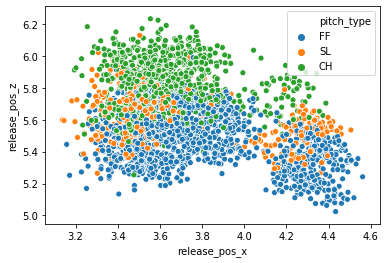Using Machine Learning to Quantify Deception
As the baseball community has recently seen with the Astros 2017 cheating scandal, knowing what pitch is being thrown gives batters a game-breaking advantage. However, unless you have an intricate system of cameras and trash cans set up, knowing what pitch is about to be thrown is incredibly difficult. Batters have mere fractions of a second to pick up on signals that might indicate the type of pitch coming their way and even fewer milliseconds to process and act on that information. Signals that could indicate what pitch is being thrown could be a subconscious tell from the pitcher or a sign from a runner looking in at second. But these are either situational or easily avoided by experienced pitchers. A much harder to avoid pitch indicator is the pitcher’s release point.

Sean Manaea’s release points for pitches thrown in 2018–2019
The figure above shows Oakland A’s pitcher Sean Manaea’s release point for all of his pitches thrown since 2018. As we can see from the plot, there are relatively distinct differences in release point depending on the type of pitch. For Manaea, he tends to release his fastball lower than any other pitch and his changeup is, on average, released at the highest point. An observant batter could pick up on these signals and use them to their advantage. No trash cans needed, just skill. However, not all pitchers have such distinct differences in their release point. Take Justin Verlander for example:
#classification #baseball #machine-learning #sabermetrics #mlb #deep learning